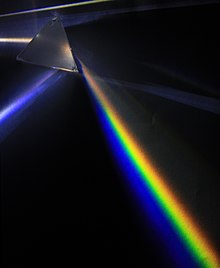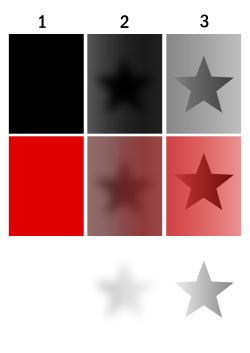Modern Photography/Light
As the raw medium behind photography, it is important to understand the basic properties of light.
Types of light
[edit | edit source]By direction
[edit | edit source]Sometimes light is describes by its relative direction. Note that while the terms below describe the extremes of this property of light, in reality there is a constant progression from ambient to directional.
Ambient light
[edit | edit source]Ambient or 'all around' light, is good natural light which lights everything from many directions. It is the sort of "cloudy day view" you get of subjects with no clear shadows. Ambient light from the sun is greatest at midday on clear days, and may be bright enough to fully obscure any visible effect of artificial directional lights.
Diffuse light
[edit | edit source]Diffuse light is light which comes from multiple directions (ambient light is a subtype of diffuse light). A good example of a diffuse light would be the lights used by portrait photographers that bounce either constant light or flashes from a broadly curved surface in order to scatter it in a range of directions. Diffuse light provides excellent detail resolution and prevents hard shadows.
Directional light
[edit | edit source]Directional light is that which comes from one direction and therefore casts shadows. The terms 'point light' or 'spot light' are sometimes used interchangeably, but usually only with reference to artificial direction light such as that from lamps. Very early and late in the day are good for the natural provision of directional light, however at this time the light will also be softer (see below). The angle of your camera versus the angle of the light can play a huge difference in defining the quality of the tones in your image.
By origin
[edit | edit source]Natural light
[edit | edit source]Sunlight, at an effective temperature of 5,780 kelvins, is composed of nearly thermal-spectrum radiation that is slightly more than half infrared. At midday, sunlight provides an irradiance of just over 1 kilowatt per square meter at sea level. Of this energy, 527 watts is infrared radiation, 445 watts is visible light, and 32 watts is ultraviolet radiation.
Early in the morning and late in the evening, natural light will be softer (not as bright, cast fuzzier shadows, be more diffuse) than at midday, when it is considered to be harsh (very bright, casting extreme shadows, being highly directional).
Understanding and working successfully with a range of natural lighting conditions is a key skill for photographers, and is particularly important for event photographers such as sports and wedding photographers, journalists, etc. as well as nature photographers who do not wish to artificially light their subjects and detract from their natural appearance.
Artificial light
[edit | edit source]Today we can reliably produce light of any character with artificial lighting equipment. Once upon a time it was possible to characterize artificial light, but today this is not possible due to the broad range of devices available. We will explore the developments in artificial lighting in the Light and photography section, below.
By harshness/hardness
[edit | edit source]Harsh/hard light
[edit | edit source]Light which is hard or harsh is that which is bright and directional (non-diffuse). It casts very strong shadows and emphasizes the form and, at some angles on some surfaces, texture of a subject. The classic example of harsh/hard light is the midday sun on a clear day.
Soft light
[edit | edit source]The opposite of harsh or hard light is soft light. Soft light is that which is less bright and less directional (more diffuse). It casts softer shadows and emphasizes the detail of a subject, without emphasizing texture. A classic example of soft light is the glow of a lava lamp or a digital display screen.
By wavelength
[edit | edit source]Infrared
[edit | edit source]
Infrared (IR) is invisible radiant energy, electromagnetic radiation with longer wavelengths than those of visible light, extending from the nominal red edge of the visible spectrum at 700 nanometers (frequency 430 THz) to 1 mm (300 GHz), although people can see infrared up to at least 1050 nm in experiments. Most of the thermal radiation emitted by objects near room temperature is infrared.
The infrared spectrum is often divided in to Near Infrared (NIR), Short-wavelength infrared (SWIR), Mid-wavelength infrared (MWIR), Long-wavelength infrared (LWIR) and Far Infrared (FIR). NIR and SWIR is sometimes called "reflected infrared", whereas MWIR and LWIR is sometimes referred to as "thermal infrared". Due to the nature of the blackbody radiation curves, typical "hot" objects, such as exhaust pipes, often appear brighter in the MW compared to the same object viewed in the LW.
Infrared is used in night vision equipment when there is insufficient visible light to see.[21] Night vision devices operate through a process involving the conversion of ambient light photons into electrons that are then amplified by a chemical and electrical process and then converted back into visible light.[21] Infrared light sources can be used to augment the available ambient light for conversion by night vision devices, increasing in-the-dark visibility without actually using a visible light source.
The use of infrared light and night vision devices should not be confused with thermal imaging, which creates images based on differences in surface temperature by detecting infrared radiation (heat) that emanates from objects and their surrounding environment, and can be used to remotely determine the temperature of objects if the emissivity is known. This is termed thermography, or in the case of very hot objects in the NIR or visible it is termed pyrometry. Thermography (thermal imaging) is mainly used in military and industrial applications but the technology is reaching the public market in the form of infrared cameras on cars due to the massively reduced production costs.
Thermographic cameras detect radiation in the infrared range of the electromagnetic spectrum (roughly 900–14,000 nanometers or 0.9–14 μm) and produce images of that radiation. Since infrared radiation is emitted by all objects based on their temperatures, according to the black body radiation law, thermography makes it possible to "see" one's environment with or without visible illumination. The amount of radiation emitted by an object increases with temperature, therefore thermography allows one to see variations in temperature (hence the name).
On the surface of Earth, at far lower temperatures than the surface of the Sun, almost all thermal radiation consists of infrared in various wavelengths. Of these natural thermal radiation processes only lightning and natural fires are hot enough to produce much visible energy, and fires produce far more infrared than visible-light energy.
Ultra-violet
[edit | edit source]Visible
[edit | edit source]
Visible light is usually approximately divided by colour. A rainbow is a natural display of the visible light spectrum, caused by light passing through water droplets in the air. Prior to visible light in the table below is ultra-violet light. After visible light is infra-red light.
Basic optics
[edit | edit source]Reflection
[edit | edit source]Reflection is the process by which light bounces off a subject. In this case, the angle of incidence (the angle at which is approaches a flat subject) is said to be equal to the angle of reflection (the angle at which is leaves a flat subject). Note that few surfaces are perfect reflectors, in reality reflected light will approximate the angle of incidence in its angle of reflection only, due to surface imperfections in the reflective medium. Thus, reflected light is typically more diffuse (less directional) than light before reflection.

Refraction
[edit | edit source]Refraction is the change in direction of propagation of a wave (in the case of photography, light) due to a change in its transmission medium. In photography, we of course require a semi-transparent (not opaque) medium, ie. one which permits light to flow through it. The medium also requires a density greater than air. The most common refractive mediums used in photography are water and glass or other crystalline solids. Objects half-within one medium and half-within another will appear bent, like a pencil placed in a glass of water, or a swimmer in a pool.

Transparency and translucency
[edit | edit source]An object is said to be transparent when it allows light to pass through without scattering it to the point where an image cannot be made out. For example, a glass window is normally transparent. An object is said to be translucent when it allows light to pass through but scatters it to the point where no image can be made out. For example, an opaque glass window, or a thick glass brick. The opposite of transparency (permitting light to pass through and form an image on the other side) is opacity. An object with complete opacity is one you can't see through at all. Such an object is said to be opaque. An example of an opaque object is a plank of wood.


Measurement of light
[edit | edit source]Light and photography
[edit | edit source]Now that we have some understanding of the general nature of light, let's look more specifically at how it is worked with during photography.
Available light photography
[edit | edit source]Photographs taken using the light already available in a scene are known as available light photographs. Available light photographs promise the most natural and honest representation of a scene from the perspectives of overall scene balance, colour reproduction, tonal depth and texture visibility. However, some scenes are simply too dark for a good photograph, others are pretty flat and boring, and occasionally we want to add drama or simply experiment.
In the early days of photography, photographic medium were not as sensitive as the digital sensors available today, so exposing a good photograph in anything less than broad daylight tended to require a very long exposure time (many seconds, even minutes) and thus caused issues due to movement (even minute movement such as breathing during portraiture) and so became highly problematic. Today we are lucky that we do not have such issues, and can generally obtain good results with available light in most conditions.
Artificial light photography
[edit | edit source]Photographs using artificial light are most often known as flash photography, where a momentary light source is used such as the classic camera-attached (or built-in) directional flash unit, though there are other types of artificially lit photographs. Turning on the light in a room also counts as artificial light photography, as does setting up a non-camera connected lighting system that a provides continuous rather than momentary source of additional light.
The first artificial light sources for photography were burning magnesium based flash lamps developed in the mid 19th century.

Flash as fill light
[edit | edit source]Instead of relying solely upon artificial or natural light, it is usually the case that a flash is used to augment available light to achieve a different, more useful result. The classic example is fill light, whereupon a subject standing in front of a light source such as a window or sunset that would cause relative silhouetting to occur (loss of color depth, brightness and detail) may be 're-lit' and thus saved from appearing as a dark lump of nothing. However, the tonal depth of a flash-filled subject will rarely equate to that of natural light.

Triggering systems
[edit | edit source]Flashes are often rigged to trigger either when another flash is triggered (sometimes described as a slave/master configuration), when the camera shutter is depressed, or on a separate trigger system based upon light, sound, or some other form of sensor.
